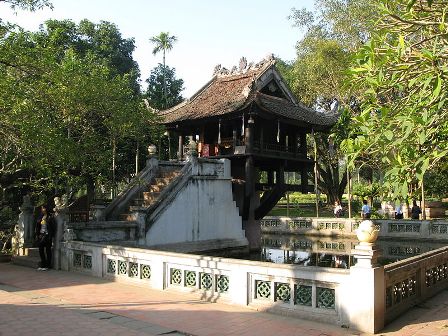One Pillar Pagoda recognised as unique example of Asian architecture

One-pillar pagoda is a tourist attraction in Hanoi
According to Dai Viet Su Ky Toan Thu, The Complete History of Great Viet, the pagoda was built in the winter of 1049 under the reign of King Ly Thai Tong who dreamed of seeing the Goddess of Mercy sitting in a lotus throne and talking him to it. When awaking, the king told his mandarins about his dream and one of them thought that it was a bad omen. Monk Thien Tue advised him to build a pagoda and a lotus-shaped tower just as he had seen in his dream. When the pagoda was inaugurated, monks went around the pagoda and recited the Buddhist scriptures to pray for longevity of the king. For this reason, the pagoda is also called Dien Huu (long lasting happiness and good luck).
The temple is built of wood on a single concrete pillar 1.25 metres in diameter. It is designed to resemble a lotus blossom, which is a Buddhist symbol of purity, since a lotus blossoms in a muddy pond.
After being repaired many times, the pagoda was destroyed by the French colonists in 1954. In 1955, the government had the pagoda rebuilt. The present wood pagoda is in the shape of square with each side and a curved roof. It was designed to resemble a lotus stretching up out of the square pond and placed on a pillar including two blocks which are connected together. This stone pillar is approximately 4 metres high (excluding the underground section) and 1.2 metres in diameter. The pagoda structure also shows the harmonious combination of imagination and unique architecture with a system of wood beams that create the solidity and beauty for the pagoda.
With its architectural and historical values, the pagoda was classified as a historical relic on April 28, 1962. On May 4, 2006, it was recorded in the Vietnamese Guinness Book as the pagoda with the most unique architecture in Vietnam.
What the stars mean:
★ Poor ★ ★ Promising ★★★ Good ★★★★ Very good ★★★★★ Exceptional
 Tag:
Tag:
Related Contents
Latest News
More News
- The destinations powering Vietnam’s festive season travel demand (December 04, 2025 | 18:33)
- Vietnam named among the world’s most exciting winter destinations (December 04, 2025 | 15:10)
- Phu Tho emerges as northern Vietnam’s new tourism hub (December 01, 2025 | 17:00)
- Vietjet completes Airbus A320/A321 updates ahead of deadline (December 01, 2025 | 09:49)
- Vietjet resumes Con Dao flights from early December (November 28, 2025 | 15:24)
- Free tickets, Lunar New Year promotions on offer at Vietjet Mega Livestream (November 26, 2025 | 15:32)
- Scandinavian Airlines and Vietnam Airlines broaden agreement with new routes (November 25, 2025 | 17:04)
- Halong Cruise Port welcomes over 3,100 international visitors (November 12, 2025 | 18:06)
- Vietnam.travel climbs to second place in Southeast Asia website rankings (November 12, 2025 | 18:01)
- Cat Ba named among Southeast Asia’s top island adventures (November 11, 2025 | 18:09)



















 Mobile Version
Mobile Version